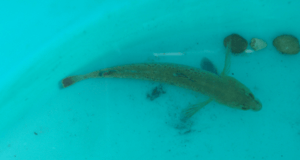Redfin darter facts for kids
Quick facts for kids Redfin darter |
|
|---|---|
 |
|
| Conservation status | |
| Scientific classification | |
| Synonyms | |
|
Boleichthys whipplii Girard, 1859 |
The redfin darter (Etheostoma whipplei) is a small, colorful freshwater fish. It is a type of ray-finned fish and belongs to the darter group. This group is part of the Percidae family, which also includes well-known fish like perch. You can find redfin darters in the south-central United States. They live in states such as Missouri, Arkansas, Kansas, and eastern Oklahoma.
Contents
What the Redfin Darter Looks Like
Redfin darters can grow up to about 9 centimeters (3.5 inches) long. However, most are usually around 5.5 centimeters (2.2 inches). Female darters and young fish are often grayish with mottled patterns. They have 8 to 10 faint saddle-like marks on their backs.
Their snout is a bit pointy, and their lips are dark. They have clear bars that go across their eyes, making a cross shape. The bar in front of the eye almost connects to the bar on the other side of the upper lip. This makes it look like a spear if you see it from above.
Redfin darters have an incomplete lateral line. This is a special line of sensory cells along their body. Their cheeks and chest area look smooth, almost without scales.
Male darters, especially during breeding season, have bright colors. They show vivid red spots on their sides. Some males in central Louisiana might have less bright spots. Their top fin (dorsal fin) has red spots near the base. Above these spots is a golden area, then a bright red band, and finally a deep blue band at the edge of the fin. Their bottom fin (anal fin) has a red base with the same deep blue color at its edges.
Where the Redfin Darter Lives
The redfin darter mostly lives in small rivers. They prefer areas with gravel or rocky bottoms called riffles. Riffles are shallow, fast-moving parts of a stream. In some places, like Louisiana and Mississippi, they also live near water plants.
Reproduction and Life Cycle
Redfin darters lay their eggs over a period of about 2.7 to 3 months. This usually happens from February to May. A female darter can lay between 31 and 207 eggs at one time. Male darters are ready to breed earlier than females. They are also generally larger than the females.
The eggs are quite small, measuring about 0.89 to 1.18 millimeters across. When the eggs are fully ready to be laid, they are a bit larger, around 1.17 to 1.27 millimeters. During the breeding season, male darters become very colorful. They show bright red and blue colors on their fins and bodies. This is similar to another fish called the Gulf darter.
Where the Name Comes From
The scientific name for the redfin darter, Etheostoma whipplei, honors Amiel Weeks Whipple. He was an officer in the United States Army. During his expeditions, many new plants and animals were discovered and described for the first time.
Images for kids
See also
 In Spanish: Etheostoma whipplei para niños
In Spanish: Etheostoma whipplei para niños



